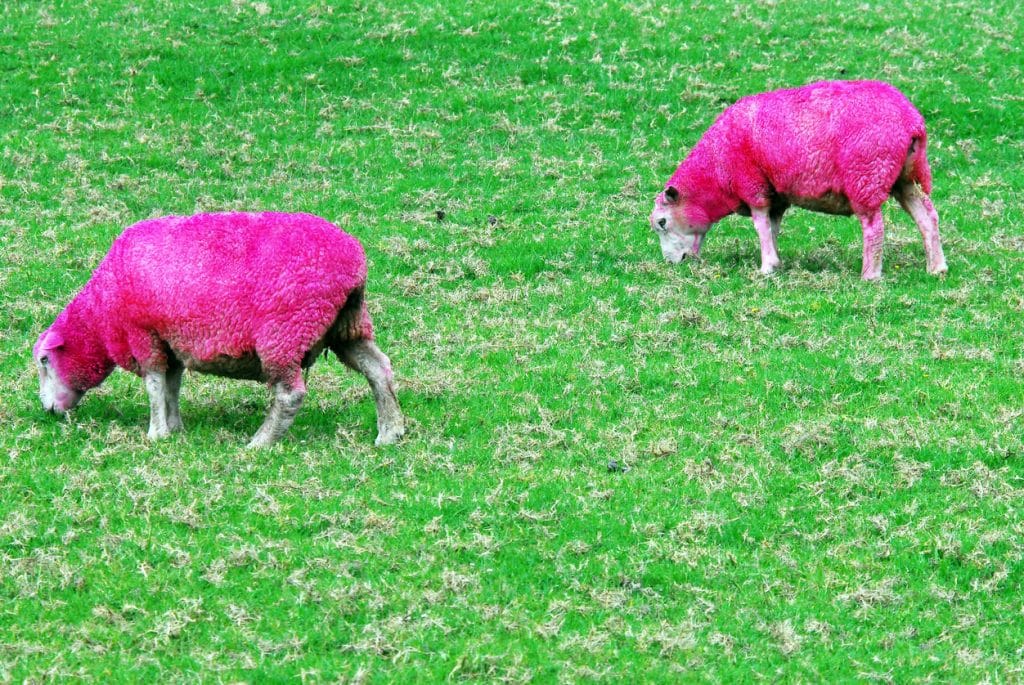You may have heard about the Latitude Festival, one of the UK’s top summer events. But this isn’t your usual festival roundup. There’s been a bit of a hullabaloo involving… wait for it… pink sheep! Yup, you read that right. This festival, known for its colorful atmosphere and eclectic line-ups, stirred up a storm when they decided to dye a flock of sheep pink as part of their marketing campaign. Now, you might be thinking, “What’s the big deal?” Well, as it turns out, quite a lot.
The Latitude Festival’s Marketing Tactic: Pink Sheep
The festival’s organizers thought it would be a great idea to add a dash of pink to their green pastures. The plan was simple: take a flock of sheep and dye them a vivid fuchsia, making a living, breathing (and rather fluffy) extension of the festival’s vibrant personality.
How the Sheep Were Dyed Pink
This wasn’t just a case of breaking out the spray cans and giving the sheep a quick once-over. Latitude explained that the sheep were “dip-dyed” using a natural, water-based dye. According to them, this was akin to a routine part of farm life, where similar dips are used to fend off creepy crawlies like itch-mites, blow-flies, ticks, and lice.
The Festival’s Intentions and Goals With the Stunt
The plan was clear: create a spectacle that would get people talking, create buzz around the festival, and make for some pretty unforgettable social media snapshots. The festival grounds, with a dash of pink roaming around, would be an unforgettable sight, or so they thought.
Public Reaction to the Pink Sheep
The public, however, had a different take. As images of the fuchsia flock started to spread on social media, criticism began to pour in.
Initial Public Response and the Role of Social Media
A single tweet was all it took. The festival organizers posted a promotional tweet featuring the dyed sheep frolicking across the festival grounds. Almost immediately, social media users began to voice their concern, demanding an explanation for the spectacle.
Boycott Actions and Petitions
As the controversy escalated, some people took a step further than expressing their dismay online. Members of the public announced a boycott of Latitude, urging others to follow suit. An online petition was also set up, calling on Latitude to stop using the sheep as party props and remove them from the festival grounds.
Animal Rights Organizations’ Criticisms
Not surprisingly, animal rights organizations were at the forefront of the criticism. Let’s dive into what some of the leading voices had to say.
Peta UK’s Stance on the Issue
Peta UK didn’t mince words when they condemned Latitude’s actions as a “thoughtless, attention-grabbing stunt.” They voiced their concerns about the sheep being completely submerged in the dye, their heads likely held down. Peta also pointed out that these gentle animals could be easily stressed, and the loud music and rowdy festivalgoers would have only added to their distress.
The RSPCA’s Response
The RSPCA, another prominent animal welfare charity, also expressed its disapproval. The charity stated that it was “very sad” to see sheep being treated in this manner. They too called for the festival to stop using the sheep as party props and to remove the animals from the festival grounds.
Latitude Festival’s Defense
As the controversy grew, the Latitude festival didn’t remain silent. They defended their actions, providing some insights into their rationale and the steps they took to ensure the sheep’s welfare.
Latitude’s Response to the Criticisms
In response to the backlash, Latitude defended their dyeing escapade, stating that the water-based dye was completely safe and that the sheep were used to this kind of treatment as part of their normal farm life. They made it clear that their goal wasn’t to harm or stress the sheep but to add a unique element to the festival.
East Suffolk Council’s Support for Latitude Festival
Another important player in this saga is the East Suffolk Council. They not only supported the festival’s actions but also took a stand against the growing criticisms.
The Council’s Statement on Behalf of Latitude
The East Suffolk council came forward to back Latitude, stating that they had “no concerns about the sheep this year or in the 14 years that this activity has taken place”. They stressed that the festival organizers had taken all appropriate steps to ensure the animals were content, safe, and well-looked after.
Their Stance on Animal Welfare in Relation to the Festival
The council was clear about their commitment to animal welfare. They stated that if they had encountered any issues or felt that the sheep were suffering distress of any kind, they would not permit such an activity. In other words, they stood by the festival, confirming that they believed no harm was done to the sheep.
Other Instances of Sheep Dyeing: Dartmoor’s Orange Sheep
To put this all in perspective, let’s step away from the festival grounds and take a trip to Dartmoor, where a farmer dyed his sheep orange. And no, this wasn’t for a festival.
Overview of the Dartmoor Farmer’s Decision to Dye Sheep Orange
John Heard, a Dartmoor farmer, dyed his sheep orange for a very different reason – to deter rustlers. After losing 200 sheep from his farm near Okehampton, Heard took a creative approach to prevent theft. The dyed sheep, with their highly identifiable coats, seemed to put the rustlers off.
The Process and Effects of the Dyeing
Heard used a dye that was harmless to the animals and would have almost grown out by shearing time in July. Not only did this unique approach deter theft, but it also helped manage the sheep on the moor by making them easier to spot.
Analysis and Discussion
Now, let’s take a step back and look at the bigger picture. It’s clear that dying sheep for various reasons isn’t unheard of. But are all instances painted with the same brush?
Comparison of the Latitude Festival and Dartmoor Instances
While both Latitude and Dartmoor involved dyeing sheep, the purposes and public reactions were vastly different. Latitude’s intentions were promotional, aiming to create a spectacle and attract attention. On the other hand, the Dartmoor instance was a practical response to a problem: theft. The public reactions also contrasted sharply, with Latitude facing backlash and Dartmoor garnering more understanding.
Reflection on the Ethical Considerations of Using Animals in Marketing and Promotions
These instances bring up an important discussion about the role of animals in marketing and promotions. Is it ethical to use animals in this way, even if their physical health isn’t compromised? What alternatives could be used to create buzz without involving animals? These are crucial questions that need to be considered, not just by festival organizers, but by all of us.
Conclusion
The tale of Latitude’s pink sheep is a clear reminder that public opinion, animal welfare, and marketing tactics can sometimes clash in unexpected ways. While it’s important for events to create a unique atmosphere and memorable moments, the means of achieving these goals must be carefully considered. The backlash faced by Latitude serves as a lesson for all event organizers: every decision, no matter how creative or well-intentioned, should be evaluated for its potential implications and effects.
In the end, it boils down to respect – for attendees, for public opinion, and most importantly, for the animals involved. After all, festivals are meant to be a celebration of life and creativity, and it’s essential that this celebration doesn’t come at the expense of our furry friends.
Key Takeaways from the Latitude Festival’s Pink Sheep Controversy
Let’s wrap this up with some key takeaways from the whole Latitude pink sheep saga:
Marketing tactics can sometimes backfire:
Latitude’s pink sheep were meant to be a fun, unique marketing gimmick. But they ended up sparking a controversy that took over the festival’s narrative.
Animal welfare is a sensitive issue:
Even with assurances that the sheep weren’t harmed, many people were upset by the idea of using animals in this way. This highlights how sensitive and important the issue of animal welfare is to many people.
The importance of considering public opinion:
Latitude’s experience serves as a reminder of the power of public opinion, especially in the age of social media. It’s crucial to anticipate potential public reactions and consider them in decision-making processes.
Ethical considerations in marketing and promotions:
This controversy brings to light the ethical considerations involved when using animals in marketing and promotions. It prompts a discussion about where we should draw the line in the quest for attention-grabbing tactics.
So, the next time you see a flock of vividly dyed sheep, or any other unusual marketing stunt, take a moment to consider the bigger picture. It’s about more than just a splash of color. It’s a complex blend of creativity, ethics, public opinion, and the ever-important question of how we treat our animal companions in our quest for unforgettable experiences.

